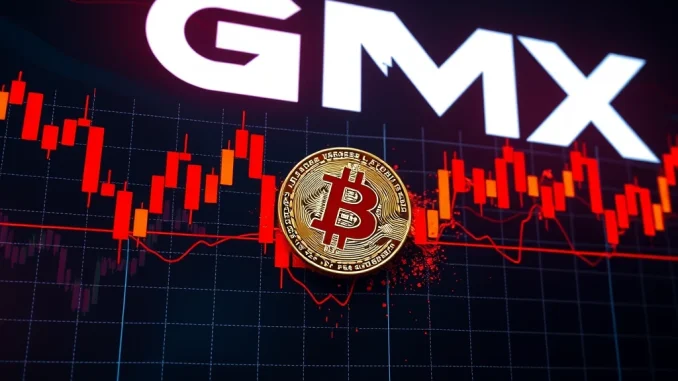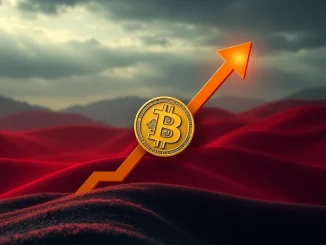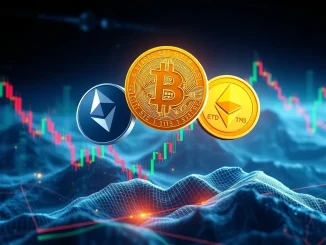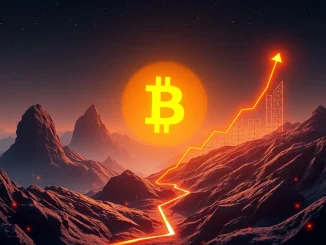
Hold onto your hats, crypto enthusiasts! The decentralized finance (DeFi) space just witnessed a dramatic event that sent ripples through the market. A colossal Bitcoin liquidation on GMX v1, a popular decentralized derivatives exchange, triggered a staggering $13 million in fees. This isn’t just another day in crypto; it’s a stark reminder of the volatile yet potentially lucrative nature of decentralized trading platforms. Let’s dive into what happened, why it matters, and what it means for you.
Understanding the Bitcoin Liquidation Event on GMX v1
So, what exactly transpired? Crypto trader SigmaSquared, a keen observer of market dynamics, brought to light on X (formerly Twitter) that a substantial Bitcoin (BTC) position on GMX v1 faced a forced liquidation. In simpler terms, a trader who had borrowed funds to amplify their bet on Bitcoin’s price movement was caught on the wrong side when the market shifted. Due to insufficient margin to cover losses, the protocol automatically closed out the position to protect lenders. This automated process is a core feature of many DeFi platforms, designed to maintain market stability and protect user funds.
Here’s a breakdown of the key elements:
- Platform: GMX v1 – A decentralized perpetual futures and spot exchange built on Arbitrum and Avalanche. It allows users to trade cryptocurrencies with leverage directly from their wallets.
- Asset: Bitcoin (BTC) – The world’s leading cryptocurrency, known for its volatility and influence on the broader crypto market.
- Event: Liquidation – The forced closing of a leveraged trading position due to insufficient margin. This occurs when the trader’s position moves against them, and their collateral is no longer enough to cover potential losses.
- Fees Generated: Over $13 million – This massive fee generation is a direct consequence of the size of the liquidated position and the protocol’s mechanisms.
This event highlights both the risks and the opportunities inherent in leveraged crypto derivatives trading, especially on decentralized platforms.
Why $13 Million in Fees is a Big Deal in DeFi
Thirteen million dollars is not pocket change, even in the fast-paced world of cryptocurrency. To put this into perspective, these fees represent a significant influx of capital into the GMX v1 ecosystem. But where does this money go, and why should you care?
According to the protocol’s rules, a substantial 30% of these generated fees are earmarked for GMX token buybacks. This is a crucial mechanism designed to:
- Increase Token Value: By using protocol revenue to buy back GMX tokens from the open market, the circulating supply decreases, potentially driving up the price of the remaining tokens. This is beneficial for GMX token holders.
- Reward Token Stakers: Often, buyback programs are coupled with token burning or distribution to stakers. This can further incentivize holding and staking GMX tokens, contributing to the platform’s long-term health and stability.
- Demonstrate Protocol Health: Large fee generation and subsequent buybacks can be seen as a positive signal of the protocol’s activity and revenue generation capabilities, attracting more users and investors.
In essence, this Bitcoin liquidation event, while unfortunate for the individual trader, injects significant value back into the GMX ecosystem, benefiting the community of token holders and stakers.
Decentralized Exchange (DEX) Dynamics and Liquidation Risks
This event underscores the unique dynamics of decentralized exchanges (DEXs) like GMX v1, particularly when compared to centralized exchanges. While DEXs offer benefits like self-custody of funds and greater transparency, they also come with specific risks and considerations:
| Feature | Decentralized Exchanges (DEXs) like GMX v1 | Centralized Exchanges (CEXs) |
|---|---|---|
| Custody of Funds | Users retain control of their private keys and funds. | Users deposit funds with the exchange, relinquishing custody. |
| Transparency | Transactions and protocol rules are often publicly auditable on the blockchain. | Transparency can vary; order books and internal operations are not always fully transparent. |
| Liquidation Mechanisms | Automated and rule-based, executed by smart contracts. | Liquidation processes can be less transparent and potentially subject to exchange discretion. |
| Counterparty Risk | Reduced counterparty risk as users interact directly with the protocol, not a central entity. | Higher counterparty risk as users rely on the exchange’s solvency and security. |
| Accessibility | Generally more accessible globally, often requiring just a crypto wallet. | May have geographical restrictions and stricter KYC/AML requirements. |
When it comes to liquidations, DEXs typically operate with pre-defined, transparent rules enforced by smart contracts. This means liquidations are often more predictable and less prone to manipulation compared to potentially opaque processes on some centralized platforms. However, the speed and automation of DEX liquidations can also be unforgiving, especially during periods of high market volatility.
Navigating the World of Crypto Derivatives and DeFi Fees
The incident on GMX v1 serves as a crucial learning moment for anyone involved in crypto derivatives trading, particularly within the DeFi ecosystem. Here are some actionable insights to consider:
- Understand Leverage Risks: Leverage amplifies both gains and losses. Always trade with leverage you understand and can afford to lose.
- Manage Margin Carefully: Keep a close eye on your margin levels, especially in volatile markets. Set stop-loss orders to automatically limit potential losses.
- Know the Protocol Rules: Before trading on any DeFi platform, thoroughly understand its liquidation mechanisms, fee structures, and risk management tools.
- Diversify Your Trading: Don’t put all your eggs in one basket. Diversify your portfolio across different assets and trading strategies to mitigate risk.
- Stay Informed: Keep up-to-date with market news, protocol updates, and risk warnings from reputable sources like SigmaSquared and other crypto analysts.
The world of DeFi and DeFi fees is constantly evolving. Events like this Bitcoin liquidation are not just isolated incidents; they are valuable lessons in risk management, protocol mechanics, and the dynamic nature of decentralized finance.
Conclusion: Lessons Learned from the GMX v1 Liquidation
The $13 million Bitcoin liquidation on GMX v1 is a powerful illustration of the high-stakes environment of DeFi derivatives trading. While it highlights the inherent risks associated with leverage and market volatility, it also showcases the robust mechanisms of decentralized protocols to manage risk and reward participants. The automatic fee distribution and GMX token buyback demonstrate a system designed to redistribute value back to the community, even in the face of significant market events.
For traders, this event is a stark reminder of the importance of risk management, due diligence, and continuous learning in the crypto space. For the DeFi ecosystem, it’s a testament to the resilience and evolving sophistication of decentralized financial platforms. As DeFi continues to mature, understanding these dynamics will be crucial for navigating the opportunities and challenges that lie ahead. Stay vigilant, stay informed, and trade responsibly!



